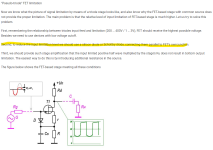BuddytheReow
Breadboard Baker
Hey All,
I'm working on a 200 Sunny Suns from Moonn Electronics. The link for the build doc is below. The build calls for 2 BAT85 diodes, which I don't have and don't really want to pay $7+ for shipping on $1 worth of parts. I think these diodes simply take any signal over the forward voltage and dump it to ground which is similar to a SHO. The data sheet says that the forward voltage is 300-500 mV depending on the current draw. I'm going to guess the current draw for this circuit is pretty low (~10mA).
I guess my question is can I substitute any diode as long as the forward voltage is around 400mV?

I'm working on a 200 Sunny Suns from Moonn Electronics. The link for the build doc is below. The build calls for 2 BAT85 diodes, which I don't have and don't really want to pay $7+ for shipping on $1 worth of parts. I think these diodes simply take any signal over the forward voltage and dump it to ground which is similar to a SHO. The data sheet says that the forward voltage is 300-500 mV depending on the current draw. I'm going to guess the current draw for this circuit is pretty low (~10mA).
I guess my question is can I substitute any diode as long as the forward voltage is around 400mV?




